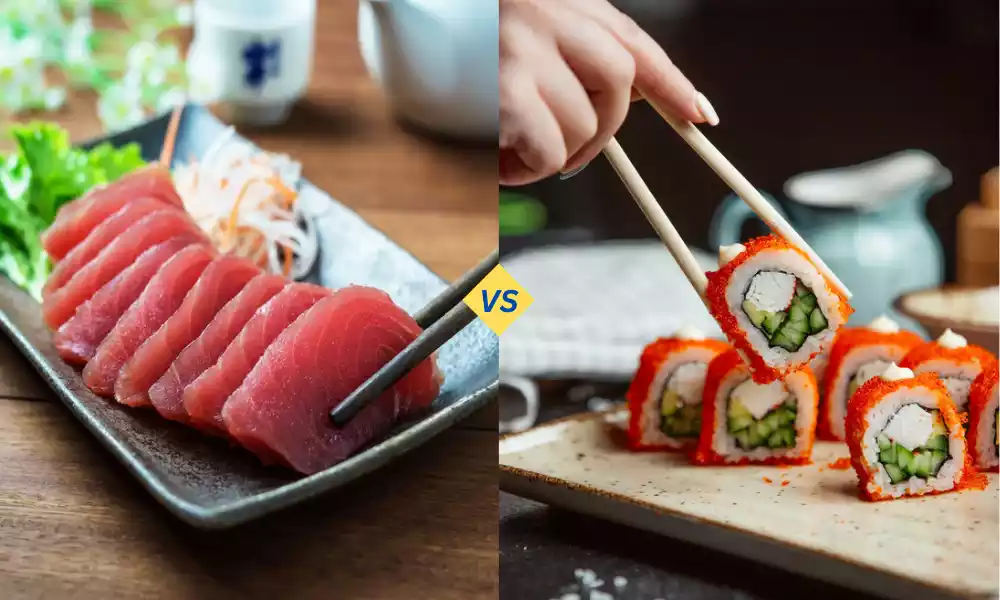Brown sugar and white sugar are both commonly used sweeteners, but they differ in several aspects. Brown sugar, characterized by its moist texture and brown color, is made by adding molasses back into refined white sugar. This gives it a distinct flavor, often described as rich, deep, or caramel-like, and it’s frequently used in baking for its moisture-retaining properties.
White sugar, on the other hand, is pure, crystallized sucrose, having a neutral sweet taste. It’s highly refined and devoid of molasses, resulting in a clean, sweet flavor that makes it versatile for a wide range of culinary applications. The choice between the two often depends on the desired flavor and texture in recipes.
Comparison table of Brown Sugar vs White Sugar
Here’s a comparison table outlining the key differences between brown sugar and white sugar:
| Aspect | Brown Sugar | White Sugar |
|---|---|---|
| Composition | Sugar (sucrose) with molasses | Refined sucrose with molasses removed |
| Color | Brown, due to molasses content | White, as molasses and impurities are removed |
| Texture | Moist and clumpy | Granular and free-flowing |
| Flavor | Rich, deep, with a caramel-like taste | Clean, sweet, neutral flavor |
| Moisture Content | Higher, due to the presence of molasses | Lower, as it lacks molasses |
| Use in Baking | Adds moisture and a distinct flavor; often used for chewier, softer baked goods | Often results in a crisper, lighter texture in baked goods |
| Nutritional Value | Slightly higher mineral content due to molasses, but overall similar to white sugar in calories | Mostly pure carbohydrates with negligible nutrient content |
| Storage | Can harden and clump if not stored properly; needs airtight storage | Longer shelf life does not clump easily, easier to store |
| Caramelization | Enhances caramelization, adding depth of flavor | Less effective in caramelization than brown sugar |
| Solubility | Dissolves slower due to moisture content | Dissolves quickly and easily in liquids |
This table helps to understand the distinct characteristics and uses of both types of sugar, aiding in making appropriate choices in various culinary contexts.
Definition of Brown Sugar
Brown sugar is a type of sugar characterized by a brown color and a moist texture, resulting from the presence of molasses. It’s either partially refined or unrefined sugar where molasses is naturally present, or it’s regular white sugar to which molasses has been added.
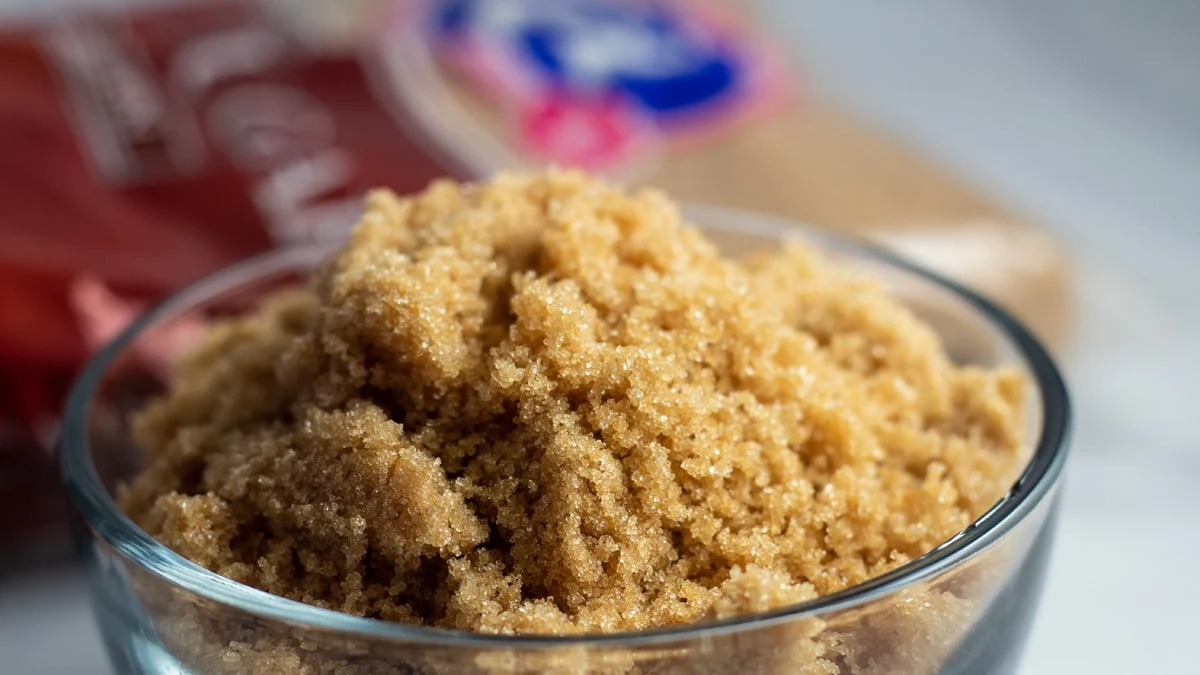
Brown sugar’s flavor is distinctly rich and deep, often likened to caramel, and it’s commonly used in baking, cooking, and as a sweetener for various beverages. The amount of molasses determines whether it is light or dark brown sugar, with dark brown sugar having a more intense molasses flavor. Brown sugar also contains minor amounts of minerals like calcium, potassium, iron, and magnesium, contributed by the molasses.
Definition of White Sugar
White sugar, also known as table sugar or granulated sugar, is a refined form of sucrose. It is produced primarily from sugar cane or sugar beets, which undergo a refining process to remove impurities and colored components, resulting in pure, crystallized sugar.
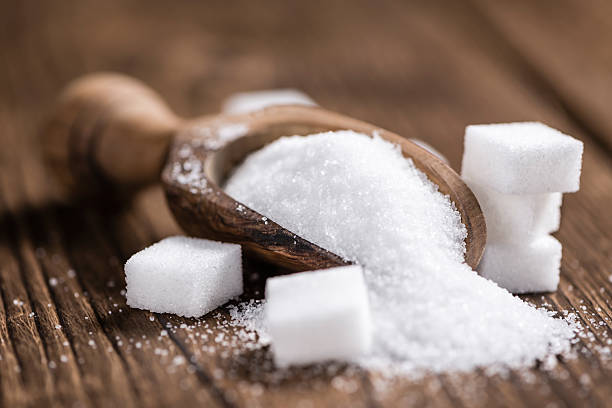
This process strips away molasses and other trace elements, leaving behind fine, white crystals that are uniform in size and color. White sugar is known for its neutral, clean sweet taste, making it a versatile ingredient widely used in baking, and cooking, and as a sweetener in beverages and various food items. It’s characterized by its ability to dissolve easily and its role as a standard sweetening agent in many culinary applications.
Importance of understanding their difference
Understanding the differences between brown sugar and white sugar is important for several reasons, particularly in cooking, baking, and nutrition:
- Flavor and Texture in Cooking and Baking: Brown sugar imparts a rich, caramel-like flavor and a moist texture to baked goods, which is different from the clean, sweet taste of white sugar. This can significantly affect the flavor profile and texture of recipes. For instance, using brown sugar in cookies can result in a softer, chewier texture, while white sugar might produce a crisper outcome.
- Moisture Content: Brown sugar has more moisture due to the presence the molasses. This is crucial in baking, as it can affect the moisture level of the final product. Recipes might need adjustments in other liquid ingredients if one type of sugar is substituted for the other.
- Color and Appearance: The molasses in brown sugar contributes to a darker color in the finished dish. This can be desirable in some recipes, like gingerbread, where a rich, deep color is preferred.
- Caramelization and Flavor Development: Brown sugar can enhance the caramelization process in cooking, adding a depth of flavor that white sugar cannot. This is particularly important in recipes like barbeque sauces or glazes.
- Nutritional Aspects: Although brown sugar contains certain minerals (like calcium, potassium, iron, and magnesium) from the molasses, the difference in nutritional value compared to white sugar is minimal. However, this understanding can be important for those closely monitoring their intake of refined sugars or for specific dietary needs.
- Storage and Handling: Brown sugar tends to clump and harden when exposed to air due to its moisture content. Proper storage (like keeping it in an airtight container) is necessary to maintain its quality, unlike white sugar, which has a longer shelf life and is less prone to clumping.
The choice between brown sugar and white sugar can have a significant impact on the taste, texture, color, and moisture content of food, and understanding these differences helps in making informed decisions in cooking and baking, as well as in nutritional considerations.
Culinary Uses
Both brown sugar and white sugar have a variety of culinary uses, each bringing unique qualities to different types of dishes:
Brown Sugar
- Baking: Brown sugar is often used in baking cookies, cakes, and pastries. It adds a moist texture and rich flavor, making it ideal for items like chocolate chip cookies, brownies, and gingerbread.
- Sauces and Glazes: It’s frequently used in barbecue sauces, glazes, and marinades, contributing a deep, caramel-like flavor and aiding in the caramelization process.
- Sweetening Beverages: Brown sugar can be used to sweeten beverages like coffee and tea, providing a unique, rich sweetness.
- Oatmeal and Breakfast Foods: It’s a popular topping for oatmeal, cereals, and other breakfast dishes, adding flavor and moisture.
- Desserts: Brown sugar is used in making dessert sauces, like caramel sauce, and in puddings and custards.
White Sugar
- Baking: White sugar is a staple in baking, used in cakes, cookies, muffins, and breads. It provides sweetness and helps with the texture and color of baked goods.
- Preserving: It’s used in making jams, jellies, and preserves, acting as a sweetener and preservative.
- Candies and Confections: White sugar is crucial in candy making, including hard candies, chocolates, and fondants.
- Sweetening Beverages: It is commonly used to sweeten drinks like coffee, tea, and cocktails.
- General Cooking: White sugar is used in a variety of savory dishes to balance flavors, particularly in Asian cuisine.
- Sauces and Dressings: It’s an ingredient in many sauces and dressings, adding a balanced sweetness.
- Caramelization: White sugar is ideal for creating caramelized toppings on desserts like crème brûlée.
Common Uses for Both
- Sweetening: Both are used to add sweetness to various dishes and beverages.
- Texture Modifier: They play a role in the texture of baked goods and confections.
- Flavor Enhancer: Both types of sugar enhance the flavor profile of a wide range of dishes.
- Color and Appearance: They contribute to the color and appearance of food, especially in baking and candy making.
The choice between brown and white sugar can depend on the desired outcome in terms of flavor, texture, and appearance. While they are sometimes interchangeable, each type can impart distinct characteristics to a dish.
Side effects of eating brown sugar
Consuming brown sugar, like any added sugar, can have several side effects, especially when consumed in excess:
- Weight Gain: Brown sugar is high in calories and can contribute to weight gain if consumed in large quantities, as part of a diet that exceeds caloric needs.
- Tooth Decay: Sugar is a leading cause of tooth decay. It feeds oral bacteria that produce acids, leading to the erosion of tooth enamel.
- Blood Sugar Spikes: Brown sugar can cause spikes in blood glucose levels, which is particularly concerning for individuals with diabetes or insulin resistance.
- Increased Risk of Heart Disease: Excessive sugar intake is associated with risk factors for heart disease, such as increased blood pressure, inflammation, and triglyceride levels.
- Liver Stress: Overconsumption of sugar, including brown sugar, can contribute to an increased risk of developing non-alcoholic fatty liver disease.
- Metabolic Syndrome: Regular, excessive consumption of sugar can lead to metabolic syndrome, a cluster of conditions that increase the risk of heart disease, stroke, and type 2 diabetes.
- Addiction-Like Symptoms: Sugar can trigger the reward centers in the brain, potentially leading to cravings and a cycle of overeating similar to addiction behaviors.
- Nutrient Displacement: High sugar intake may lead to nutritional deficiencies by displacing more nutrient-dense foods in the diet.
- Impact on Skin Health: Sugar consumption can impact skin health, potentially exacerbating conditions like acne and accelerating skin aging.
- Mood Fluctuations: Sugar can affect mood, potentially leading to mood swings, irritability, and increased risk of depression and anxiety.
It’s important to consume brown sugar in moderation as part of a balanced diet and to be mindful of the overall intake of added sugars.
Side effects of eating white sugar
Consuming white sugar, especially in excess, can lead to several negative health effects. These include:
- Weight Gain and Obesity: White sugar is high in calories and can contribute to weight gain if consumed in excess, particularly as part of a diet high in calories and low in nutrients.
- Tooth Decay: Sugar is the primary reason behind tooth decay. It feeds oral bacteria, which produce acids that erode tooth enamel.
- Blood Sugar Spikes: Consuming white sugar causes rapid spikes in blood glucose levels, posing a risk for individuals with diabetes or prediabetes and potentially leading to insulin resistance over time.
- Increased Risk of Heart Disease: High sugar intake is linked to risk factors for heart disease, including high blood pressure, inflammation, high triglyceride levels, and obesity.
- Non-Alcoholic Fatty Liver Disease: Excessive sugar consumption, particularly fructose which is a component of sucrose, is associated with an increased risk of non-alcoholic fatty liver disease.
- Metabolic Syndrome: Regular, excessive sugar consumption can contribute to the development of metabolic syndrome, a cluster of conditions that raise the risk of heart disease, stroke, and type 2 diabetes.
- Nutritional Displacement: High intake of sugar can lead to nutritional deficiencies by displacing more nutrient-rich foods in the diet.
- Impact on Mental Health: Fluctuations in blood sugar levels can affect mood, potentially leading to mood swings, irritability, and an increased risk of depression and anxiety.
- Skin Aging and Acne: Sugar can contribute to skin aging through the process of glycation and is believed to exacerbate acne, although this connection is still under investigation.
- Addiction-Like Symptoms: Sugar can activate the brain’s reward system, leading to cravings and, in some cases, addiction-like eating behaviors.
Given these potential side effects, it’s important to consume white sugar in moderation as part of a balanced diet and to be mindful of overall added sugar intake.
Which is better for health brown sugar or sugar?
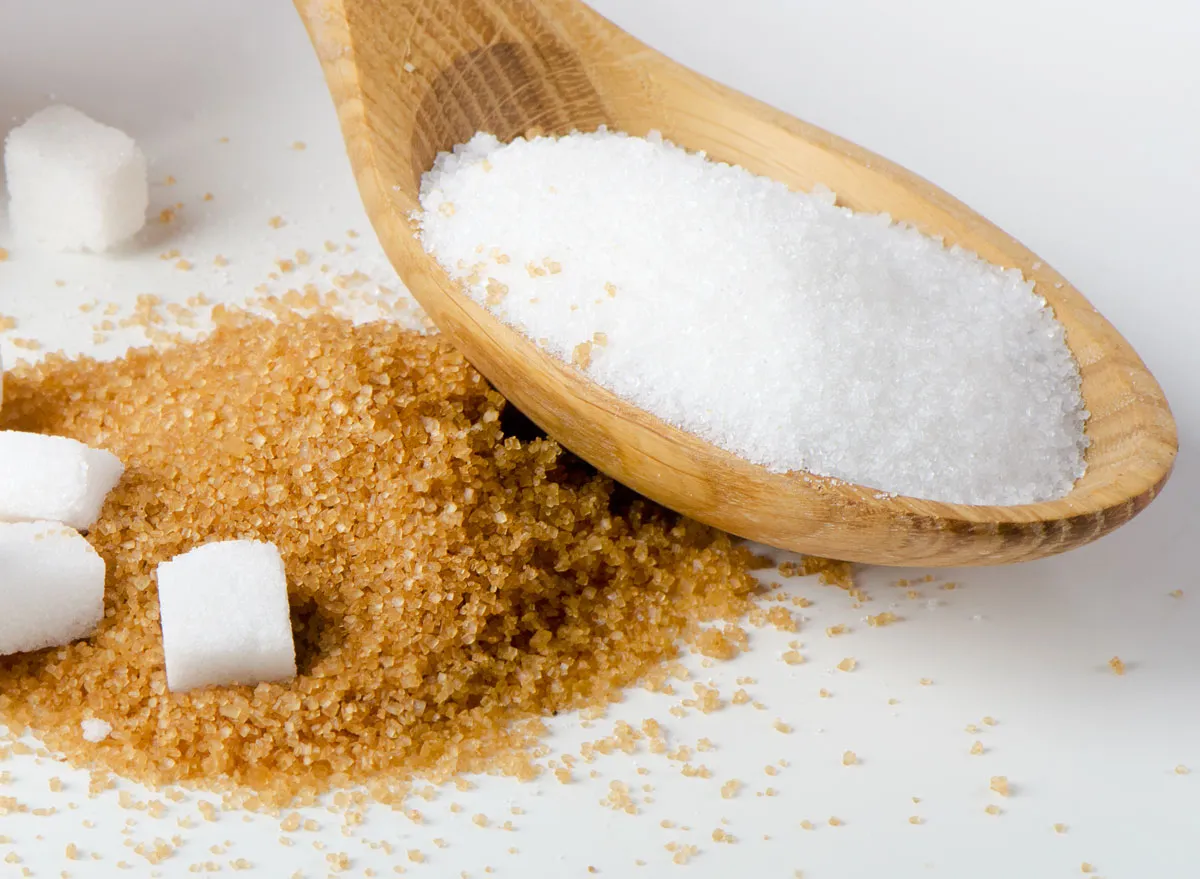
When comparing brown sugar and white sugar in terms of health, it’s important to note that they are quite similar, with a few minor differences:
- Nutritional Content: Brown sugar contains trace amounts of minerals like calcium, potassium, iron, and magnesium due to the molasses it contains. However, these amounts are very small and not sufficient to make a significant nutritional impact.
- Caloric Value: Both brown and white sugar have similar caloric values. The presence of molasses in brown sugar does not significantly alter its calorie content compared to white sugar.
- Glycemic Impact: Both sugars are primarily composed of sucrose and have similar effects on blood sugar levels. Neither offers a significant advantage for glycemic control.
- Flavor and Usage: The choice between brown and white sugar often comes down to flavor preferences and specific culinary uses rather than health benefits. Brown sugar has a distinct, rich flavor, while white sugar has a neutral, sweet taste.
- Health Impact: Both sugars, if consumed in excess, are associated with health risks such as weight gain, tooth decay, increased risk of heart disease, and other metabolic disorders.
What are the similarities between Brown Sugar and White Sugar?
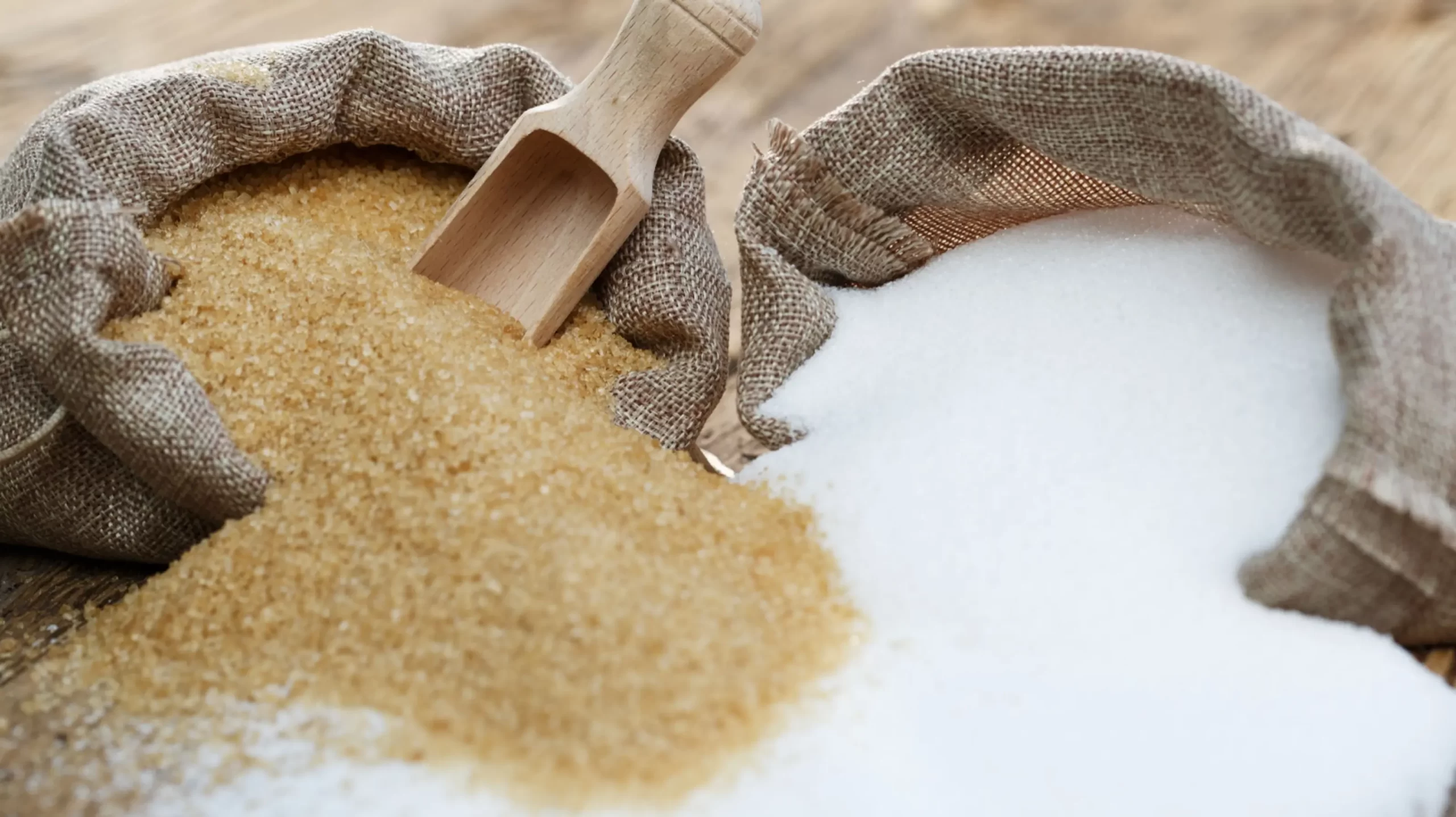
Brown sugar and white sugar, while having notable differences, also share several similarities:
- Basic Composition: Both brown and white sugar are primarily composed of sucrose. Brown sugar is white sugar but with the addition of molasses.
- Caloric Value: Both types of sugar have similar caloric values. The presence of molasses in brown sugar does not significantly alter its calorie content compared to white sugar.
- Sweetening Power: Both brown and white sugar are used as sweeteners and are capable of providing a sweet taste to foods and beverages.
- Versatility in Cooking and Baking: Both sugars are versatile and widely used in cooking and baking. They can often be used interchangeably, although the specific type of sugar can affect the flavor and texture of the final product.
- Solubility: Both are soluble in water, though the rate of solubility may vary slightly due to the moisture content in brown sugar.
- Source: Both are derived from the same sources, typically either sugar cane or sugar beets.
- Refinement Process: Both undergo a refinement process, though white sugar is more heavily refined than brown sugar.
These similarities highlight that while brown and white sugar have their unique attributes, they share a common base and functionality in culinary applications.
Health Impacts of Brown Sugar and White Sugar
Consuming sugar, including both brown and white sugar, has several health impacts. While sugar is a source of energy, its excessive consumption can lead to various health issues.
It’s important to understand these impacts to maintain a balanced and healthy diet:
Dental Health:
- Tooth Decay and Cavities: Sugars are fermented by bacteria in the mouth, producing acids that can erode tooth enamel, leading to tooth decay and cavities.
Weight Gain and Obesity:
- Caloric Density: Sugars are high in calories with little nutritional value (empty calories), which can contribute to weight gain if consumed in excess.
- Appetite and Overeating: High sugar intake can lead to a cycle of cravings and overeating, as sugar can temporarily increase energy but also lead to a quick drop in blood sugar levels, stimulating further cravings.
Blood Sugar and Insulin Resistance:
- Blood Sugar Spikes: Consuming a lot of sugar can cause spikes in blood glucose levels, especially problematic for individuals with diabetes or prediabetes.
- Insulin Resistance: Over time, high sugar consumption can contribute to insulin resistance, a risk factor for type 2 diabetes.
Heart Health:
- Cardiovascular Disease Risk: Excessive sugar intake is associated with an increased risk of cardiovascular diseases. It can lead to obesity, inflammation, high triglyceride levels, and hypertension, all of which are risk factors for heart disease.
Metabolic Syndrome:
- Cluster of Conditions: High sugar consumption is linked to the development of metabolic syndrome, a cluster of conditions including increased blood pressure, high blood sugar, excess body fat around the waist, and abnormal cholesterol levels.
Liver Health:
- Fatty Liver Disease: Excessive intake of fructose, a component of sugar, is linked to non-alcoholic fatty liver disease.
Impact on Mental Health:
- Mood Swings and Mental Health: Fluctuations in blood sugar levels can affect mood, potentially leading to irritability and increased risk of depression and anxiety.
Nutritional Displacement:
- Poor Nutrient Intake: High sugar consumption can displace more nutritious foods in the diet, leading to deficiencies in essential nutrients.
Skin Health:
- Aging and Acne: Sugar can contribute to skin aging through the process of glycation. It is also believed to exacerbate acne, although the connection is still being researched.
Addiction-Like Effects:
- Cravings and Withdrawal: Sugar can trigger reward centers in the brain, leading to cravings and, in some cases, addiction-like symptoms upon withdrawal.
To balance sugar intake within a healthy and varied diet, limiting added sugars and focusing on whole foods. Moderation is key, and individuals with specific health conditions should follow guidance from healthcare professionals regarding sugar consumption.
Conclusion
Brown sugar and white sugar, while similar in caloric content and origin, differ in flavor, texture, and nutritional value due to brown sugar’s molasses content. Brown sugar offers a moist texture and rich flavor, ideal for baking and sauces, and contains trace minerals and antioxidants. White sugar, more refined and versatile, is widely used in various culinary contexts. Both should be consumed in moderation due to potential health risks like weight gain and tooth decay, and their choice depends on desired culinary outcomes.


